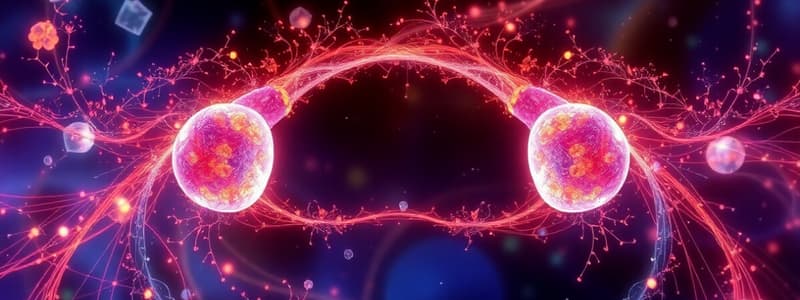Podcast
Questions and Answers
What is the twin cycle hypothesis?
What is the twin cycle hypothesis?
The twin cycle hypothesis is a model explaining the development of type 2 diabetes mellitus (T2DM) characterized by early insulin resistance and the subsequent processes involving the liver and pancreas.
Which of the following organs are included in the dysregulated lipid and glucose metabolism in T2DM?
Which of the following organs are included in the dysregulated lipid and glucose metabolism in T2DM?
- Liver
- Pancreas
- Skeletal muscle
- All of the above (correct)
What triggers the first cycle in the twin cycle hypothesis?
What triggers the first cycle in the twin cycle hypothesis?
Early insulin resistance triggered by excess caloric intake and impaired nutrient clearance.
The accumulation of fatty acids in the liver leads to _____ metabolism.
The accumulation of fatty acids in the liver leads to _____ metabolism.
What is the role of VLDL in the body?
What is the role of VLDL in the body?
Insulin resistance completely shuts off insulin production.
Insulin resistance completely shuts off insulin production.
What is one potential consequence of a fatty pancreas?
What is one potential consequence of a fatty pancreas?
What important change is observed in T2DM related to pancreatic fat?
What important change is observed in T2DM related to pancreatic fat?
In adipose tissue saturation, the ratio of leptin to adiponectin _____ in insulin resistance.
In adipose tissue saturation, the ratio of leptin to adiponectin _____ in insulin resistance.
What dietary program was implemented in the DiRECT trial for T2DM patients?
What dietary program was implemented in the DiRECT trial for T2DM patients?
Flashcards are hidden until you start studying
Study Notes
Twin Cycle Hypothesis and T2DM
- Type 2 Diabetes Mellitus (T2DM) develops from prolonged insulin resistance and is influenced by disrupted lipid and glucose metabolism in various organs: liver, muscle, pancreas, and adipose tissues.
- The twin cycle hypothesis illustrates two circular metabolic processes—one in the liver and another in the pancreas—leading to T2DM.
The First Cycle – The Liver
- Early insulin resistance starts with caloric excess and an impaired ability to clear glucose through skeletal muscle.
- When energy storage depots, primarily in subcutaneous fat and muscle, are saturated, glucose levels rise in circulation.
- Elevated free fatty acids (FFAs) in the bloodstream are a result of adipose tissue's reduced ability to convert calories into stored triglycerides.
- The liver responds to excess FFAs by:
- Burning energy via beta-oxidation
- Storing energy, leading to hepatic steatosis
- Exporting energy as Very Low-Density Lipoproteins (VLDL) which transport triglycerides to other tissues.
Insulin Resistance in the Liver
- Insulin resistance impacts balance between insulin and glucagon, crucial for liver function.
- Fat accumulation (steatosis) exacerbates insulin resistance, leading to increased glucose production and hyperglycemia.
- A positive feedback loop develops: insulin resistance increases hepatic steatosis and VLDL levels, further disrupting insulin secretion.
Circulating Free Fatty Acids
- Elevated circulating FFAs from insulin-resistant adipocytes complicate liver metabolism, causing it to repack fats into triglycerides or deposit them as lipid droplets.
- High levels of palmitic acid activate TLRs, worsening insulin resistance and hepatic stress.
The Second Cycle – The Pancreas
- T2DM shows significant changes in the pancreas, notably in fat accumulation around acinar cells and within islet cells.
- Excessive triglycerides from the liver lead to fatty infiltration of the pancreas, contributing to fibrosis and instability in beta-cell function.
- Consequences involve potential beta-cell apoptosis, increased ER stress, and de-differentiation, causing beta cells to exhibit glucagon-secreting characteristics like alpha cells.
Feedback Mechanisms
- The interplay between hepatic steatosis, VLDL production, pancreatic fat accumulation, and impaired insulin secretion fosters a continuous cycle worsening T2DM.
- This cycle leads to increased hyperglycemia and elevated circulating FFAs.
Endogenous Pathway Review
- VLDL synthesis occurs in the liver, primarily composed of triglycerides, phospholipids, and apoproteins like ApoB-100 and ApoC-II.
- VLDL transforms into Intermediate-Density Lipoproteins (IDL) and then Low-Density Lipoproteins (LDL) as triglycerides are metabolized in tissues.
- LDL clearance depends on the liver's LDL receptor, which binds ApoE and ApoB-100, but if not cleared, LDL can oxidize—linked to atherosclerosis.
Adipose Tissue Saturation
- Genetic, sex, and age factors limit how much fat can be absorbed by adipose tissue.
- Insulin resistance reduces adipose’s ability to store triglycerides, leading to increased FFAs.
- Subcutaneous fat can secrete adiponectin, enhancing insulin sensitivity, although its effectiveness decreases under T2DM.
DiRECT Trial Insights
- In a UK trial involving 306 recent T2DM patients, participants underwent a weight-loss program, drastically reducing caloric intake (825-853 kcal/day).
- At 12 months, 24% of those in the intervention group lost 15 kg or more, showcasing effective lifestyle changes in managing T2DM.
Studying That Suits You
Use AI to generate personalized quizzes and flashcards to suit your learning preferences.



